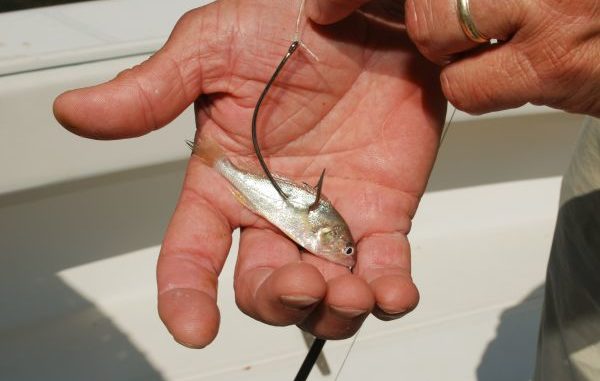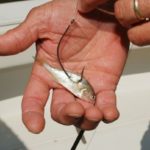
“If I don’t have live bait, I go home,” Tony Bruce said. “I’ve fished with Ed Sexton, who is excellent with plastic, and rather than fish, I just watched him fish.
Bruce’s preference is for croakers, especially large ones.
But in June, they are small, he explained. They will get larger — What he called “juicy” — in July and August, but fishing might not be quite as good as it is earlier.
Bruce will fish with shrimp, but he demands that they be “lively.” And, as with croakers, he likes big ones best.
Although both baits are almost invariable fished with bottom-hugging Texas rigs, they are worked differently.
A hit on a shrimp calls for an instant hook set, while doing so with croakers almost ensures a miss.
Instead, pause a bit after feeling the fish on the line to allow the speck to commit to taking the croaker completely in its mouth.
Shrimp are always hooked just beneath the base of the horn on top of the shrimp’s head, although Bruce allowed that hooking a shrimp through its last tail segment works well, too.
Croakers are put on hooks a number of different ways.
Craig Hunt hooks them from the bottom of the lower jaw upward through both jaws or from the bottom to the top of the upper jaw only.
Charlie Bruce prefers to hook them through the skin of one side, which makes the croaker move with fluttering movements.
Tony Bruce uses one of two options. In heavy current, he hooks croakers through the upper jaw to keep their noses into the current. In low-current conditions, he hooks the baitfish in the anus and out through the belly, which he claims allows them to be more active.
By definition, live bait must be alive, and keeping it alive can be a challenge.
Croakers and shrimp are saltwater species. If the pump on the livewell is set to circulate water from the outside when the boat runs through an area with fresh surface water from the river, it will eventually kill them.
Setting the pump on recirculate will keep saltwater in the bait well, but eventually the dissolved oxygen in the water will fall enough to kill the bait.
Tony solves the latter problem by flooding oxygen from a bottle through an air stone in his tank.
The issue is most critical during high-river discharge periods in May and June. By July and August the river gets low enough most years that salinity problems in baitwells eases.

